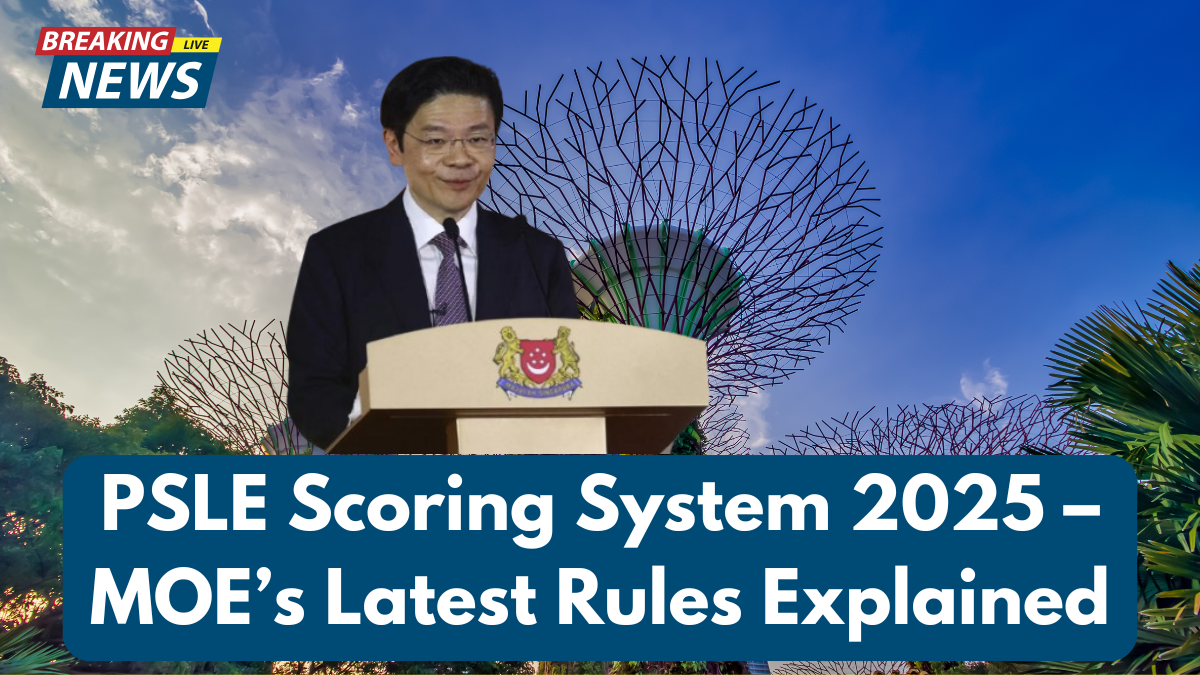Singapore’s education landscape continues to evolve, and the Ministry of Education (MOE) has made important updates to the Primary School Leaving Examination (PSLE) for 2025. The PSLE Scoring Update brings significant changes that will impact students, parents, and schools alike. With these updates, the new exam grading system is expected to make scoring more holistic and fair, reducing excessive academic pressure on young learners.
This revamped approach focuses less on academic competition and more on each child’s individual learning journey. Understanding the structure, purpose, and new rules behind the PSLE Scoring Update is essential for parents and educators looking to guide children through this critical milestone.

Key Changes in the New Exam Grading System
The most notable transformation under the new exam grading system is the shift away from the traditional T-score system. This change, which began a few years ago, is now fully refined in 2025. The T-score has been replaced by Achievement Levels (ALs), which are designed to reflect a student’s actual level of understanding rather than relative performance.
Here’s how the updated scoring works:
| Achievement Level (AL) | Raw Score Range | Description |
|---|---|---|
| AL1 | 90 – 100 | Very Good Performance |
| AL2 | 85 – 89 | Strong Understanding |
| AL3 | 80 – 84 | Good Grasp of Concepts |
| AL4 | 75 – 79 | Above Average Competency |
| AL5 to AL8 | <75 | Needs Further Strengthening |
Under the PSLE Scoring Update, each subject is graded individually from AL1 to AL8, and the total PSLE score is the sum of all four subjects’ ALs. This means the best possible score is 4, and the lowest is 32.
Why the PSLE Scoring Update Matters
The updated PSLE Scoring Update system is not just a technical revision—it represents a philosophical shift in how Singapore approaches education. By removing the bell-curve-based T-score model, students are no longer compared against their peers but assessed according to their own merit.
Some benefits of this new exam grading system include:
-
Reduced academic stress and competition among students
-
More room for holistic education, including non-academic development
-
Increased emphasis on foundational understanding
Parents can now focus on helping their children truly understand content rather than striving for perfect scores. This also allows educators to tailor teaching approaches more effectively to individual learning needs.
How Secondary School Posting Is Affected
A major concern for parents is how the PSLE Scoring Update impacts Secondary 1 posting. In 2025, the school placement process continues to use the PSLE score as the primary criterion, but tie-breaking mechanisms have evolved under the new exam grading system.
Tie-breakers are now applied in this order:
-
Citizenship (Singapore Citizens given priority)
-
Order of school choices
-
Computerised balloting (when all else is equal)
Students are encouraged to choose schools that align with their interests and strengths, rather than just cut-off scores. This is aligned with MOE’s long-term goal of creating more meaningful educational journeys.
How Parents and Students Should Prepare
With the PSLE Scoring Update in place, students and parents need to adapt their preparation strategies. It’s no longer about beating the bell curve; it’s about mastering concepts and developing long-term learning skills. Here’s what to focus on:
-
Understand the AL grading framework thoroughly
-
Prioritize conceptual understanding over memorization
-
Review past mistakes with a focus on improvement, not perfection
-
Engage in non-academic activities for well-rounded development
As the new exam grading system is designed to support growth over grades, families should embrace a mindset shift that values learning depth over competitive ranking.
Conclusion: Adapting to a More Balanced Assessment System
The PSLE Scoring Update marks a positive step toward creating a balanced, student-centric education system in Singapore. It helps move away from the long-standing obsession with perfect scores, and instead nurtures real learning, resilience, and curiosity.
With the new exam grading system in place, students can better focus on their strengths, teachers can personalize instruction, and parents can guide their children with less pressure. As we move into a future where adaptability and skills matter more than scores, this change sets the foundation for a more thoughtful and inclusive academic environment.
FAQs
What is the PSLE Scoring Update?
The PSLE Scoring Update is the latest change by MOE to replace the traditional T-score system with a new Achievement Level grading framework to reduce academic stress.
How does the new exam grading system work?
Students are graded from AL1 to AL8 for each subject, and their PSLE score is the total of these four ALs. A lower total score is better.
Why did MOE change the scoring system?
MOE introduced the new exam grading system to promote holistic development and reduce unnecessary academic pressure on young learners.
How will this affect secondary school postings?
Secondary school postings will still use PSLE scores but now involve tie-breakers like citizenship, order of school choices, and balloting.
Is this grading system better than the old T-score?
Yes, the Achievement Level system reflects true individual performance rather than comparing students against their peers, which creates a healthier learning environment.
What should parents do to help their children prepare?
Parents should help children build strong fundamentals, focus on understanding rather than memorization, and support overall well-being throughout the exam year.
Click here to learn more



